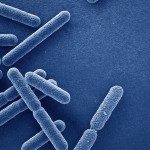 In this collaborative paper, the Team “Pathenogenesis of Microbial Anaerobes” led by Bruno Dupuy illustrates how metabolically distinct species of Clostridia protect against or worsen Clostridioides difficile infection in mice by modulating the pathogen’s colonization, growth, and virulence to impact host survival. Gnotobiotic mice colonized with the amino acid fermenter Paraclostridium bifermentans survive infection with reduced disease severity, while mice colonized with the butyrate-producer, Clostridium sardiniense, succumb more rapidly. Systematic in vivo analyses revealed how each commensal alters the gut-nutrient environment to modulate the pathogen’s metabolism, gene reg- ulatory networks, and toxin production. Oral administration of P. bifermentans rescues conventional, clinda- mycin-treated mice from lethal C. difficile infection in a manner similar to that of monocolonized animals, thereby supporting the therapeutic potential of this commensal species.
In this collaborative paper, the Team “Pathenogenesis of Microbial Anaerobes” led by Bruno Dupuy illustrates how metabolically distinct species of Clostridia protect against or worsen Clostridioides difficile infection in mice by modulating the pathogen’s colonization, growth, and virulence to impact host survival. Gnotobiotic mice colonized with the amino acid fermenter Paraclostridium bifermentans survive infection with reduced disease severity, while mice colonized with the butyrate-producer, Clostridium sardiniense, succumb more rapidly. Systematic in vivo analyses revealed how each commensal alters the gut-nutrient environment to modulate the pathogen’s metabolism, gene reg- ulatory networks, and toxin production. Oral administration of P. bifermentans rescues conventional, clinda- mycin-treated mice from lethal C. difficile infection in a manner similar to that of monocolonized animals, thereby supporting the therapeutic potential of this commensal species.
Those findings lay the foundation for mechanistically informed therapies to counter disease using systems biology approaches to define host-commensal-pathogen interactions in vivo.
In vivo commensal control of Clostridioides difficile virulence
Brintha P. Girinathan, Nicholas DiBenedetto, Jay N. Worley, Johann Peltier, Mario L. Arrieta-Ortiz, Selva Rupa Christinal Immanuel, Richard Lavin, Mary L. Delaney, Christopher K. Cummins, Maria Hoffman, Yan Luo, Narjol Gonzalez-Escalona, Marc Allard, Andrew B. Onderdonk, Georg K. Gerber, Abraham L. Sonenshein, Nitin S. Baliga, Bruno Dupuy, and Lynn Bry
https://doi.org/10.1016/j.chom.2021.09.007


